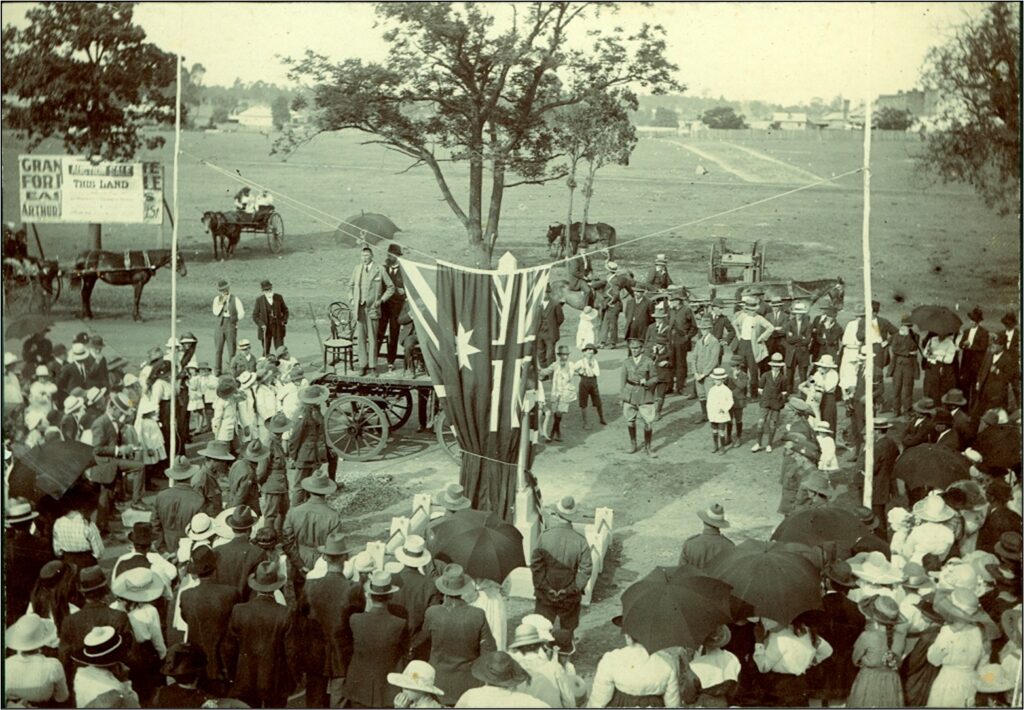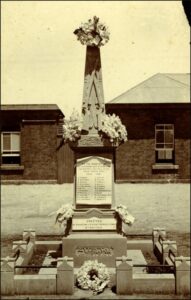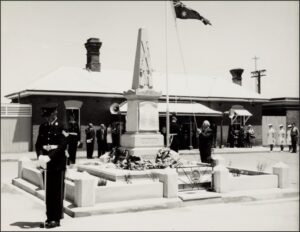by Rosemary Phillis
The Riverstone War Memorial was unveiled on Saturday 8 November 1919. It was one of the earliest in the state. Prior to January 1919 there was a Government restriction on the amount of funds that could be collected for a war memorial. When the restriction was lifted, a Committee of local residents took on the task. The Committee appears to have consisted of Councillor J. J. Pye, H. L. Lawson (Secretary), Ald. H. R. Reid, Ald. C. A. Jeffery, Mr. W. Wiggins, Mrs. Crisp and other ladies. [1]These people had been active undertaking patriotic duties such as fundraising, organising farewells and welcome home events.
The Committee obtained permission to build the Memorial on Railway Land and decided on the design (which was similar to an obelisk at Wilberforce). They raised the required amount of £100 and organised to have it installed. Their dedication and energy was amazing.
Raising the funds had its challenges. With the outbreak of the Pneumonic Flu, authorities restricted public gatherings, to try and curtail the spread of the disease. Despite the challenges the Committee raised the necessary funds and had the Memorial constructed in nine months.
The Memorial was designed and constructed by George Cook of Kingsley and Co, monument masons at Windsor. It was installed in the first week of November 1919.
The Memorial was officially unveiled by Mr. R. B. Walker, M.L.A. The ceremony started at 3.30pm. It had been an oppressively hot day, but as the service progressed, the sun went behind clouds and a gentle cooling breeze came from the south. [2]
The event was described in great detail in the Windsor and Richmond Gazette of 21 November 1919. The attendance said to have been “extremely large”. Music was provided by the Riverstone Brass Band; returned soldiers formed a guard of honour, under the command of Lieutenant F. F. Hayward. Speeches were made by the chairman, Councillor J. J. Pye; Mr. R. B. Walker, M.L.A.; Colonel J. J. Paine, V.D.; Councillors Page and Lalor; Lieutenant Hayward; Alderman H R. Reid; Cadet Morgan of the Salvation Army; Reverend Setchell and Mr Lawson representing the Memorial Committee. The last post was played during the service and proceedings brought to an end with the playing of the National Anthem. The service must have been a long one, but given the gravity of the occasion, most appropriate.
The unveiling of the Memorial was significant enough to be mentioned in The Sydney Mail newspaper of 19 November 1919. The paper featured two photos taken by local photographer Ernest William Griffin, a returned serviceman. The Gazette commented that from the position the photograph was taken ‘the big section of the crowd was not shown’. [3]

Photographer: Ernest Griffin. Photo: Voysey Collection
Over the years improvements were made to the Memorial. A fence was built around to protect it from passing traffic. A wooden flagpole was initially installed, later being replaced by metal ones. In 1966 a major renovation took place. The upgrade was to celebrate the 50th Anniversary of the R.S.L in Australia. The work was conducted for the Riverstone-Schofields RSL sub-branch by monument mason J. H. Sondermeyer.
The work involved raising the monument and utilising sandstone in the design of the base and surrounds; restoring and raising the Memorial; removing the small wire fence, installing low rise sandstone steps and attaching a small wrought iron gate, symbolising the rising sun with a small eternal flame plaque, in front of the memorial.

Photo: Davis Family
One major addition included the installation of a marble panel commemorating the men who died during the Second World War. The names came from the timber honour roll located at the local RSL club. The names were as follows: L. G. Bagot, N. S. Davies, G. Grainger, R. M. Leeson, J. H. McNamara, W. Parkes, R. B. Ratcliff and W. Whitehead. [4] A. Belshaw’s name was added later. The other major addition included having the names of various military conflicts cut into the sub-base; ‘1914-1918’ on the front; ‘1939-1945’ on the back; ‘MALAYA – KOREA’ on the right and ‘VIETNAM’ on the left.

(Mitchell Library, State Library of New South Wales and Courtesy Con Sondermeyer)
Around the early 1980s the curtilage around the Memorial was enlarged, paved and a concrete edging and protective bollards were added.
The Korean War marble panel bearing the name of Patrick Green was added sometime between 1991 and 1993.
In 2001-2002 the concrete bollards were replaced by sandstone ones and new square shaped planter boxes were installed either side of the memorial surrounds.
In 2013 larger 7.5 metre flagpoles were installed, and the small gate at the front was removed and the ‘Lest We Forget’ plaque set into sandstone paver in front of the memorial.
Around 2015 improvements were made to the Memorial surrounds. Small pavers replaced with larger pavers. Two sandstone bollards removed from the front and access ramps incorporated into the front and back of the paved area.
[1] Windsor and Richmond Gazette 20 June 1919.
[2] Windsor and Richmond Gazette, 21 November 1919.
[3] ibid
[4] Cornelis Sondermeyer papers, State Library of NSW, letter dated 3 September 1966 from Mr Sondermeyer to Mr L. Ludgate Hon. Secr. Riverstone R.S.L. Sub-Branch.
